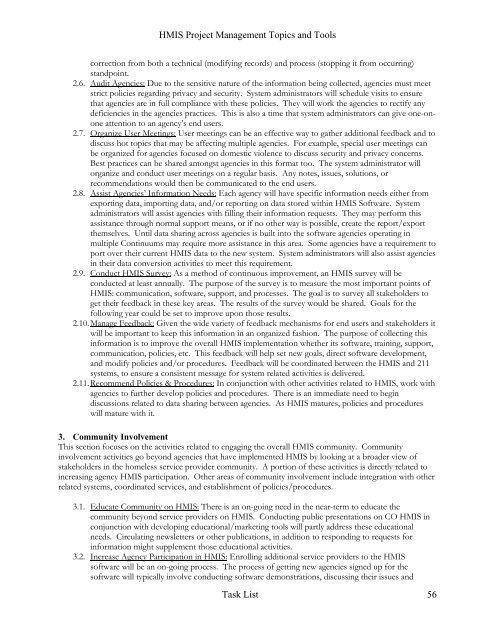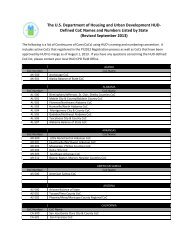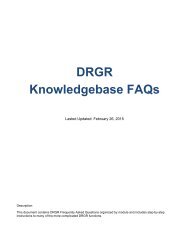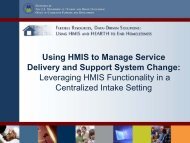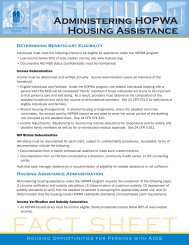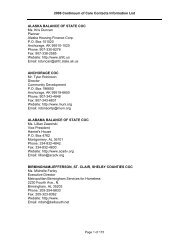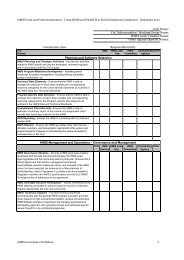HMIS Project Management Topics and Tools - OneCPD
HMIS Project Management Topics and Tools - OneCPD
HMIS Project Management Topics and Tools - OneCPD
- No tags were found...
You also want an ePaper? Increase the reach of your titles
YUMPU automatically turns print PDFs into web optimized ePapers that Google loves.
<strong>HMIS</strong> <strong>Project</strong> <strong>Management</strong> <strong>Topics</strong> <strong>and</strong> <strong>Tools</strong>correction from both a technical (modifying records) <strong>and</strong> process (stopping it from occurring)st<strong>and</strong>point.2.6. Audit Agencies: Due to the sensitive nature of the information being collected, agencies must meetstrict policies regarding privacy <strong>and</strong> security. System administrators will schedule visits to ensurethat agencies are in full compliance with these policies. They will work the agencies to rectify anydeficiencies in the agencies practices. This is also a time that system administrators can give one-ononeattention to an agency’s end users.2.7. Organize User Meetings: User meetings can be an effective way to gather additional feedback <strong>and</strong> todiscuss hot topics that may be affecting multiple agencies. For example, special user meetings canbe organized for agencies focused on domestic violence to discuss security <strong>and</strong> privacy concerns.Best practices can be shared amongst agencies in this format too. The system administrator willorganize <strong>and</strong> conduct user meetings on a regular basis. Any notes, issues, solutions, orrecommendations would then be communicated to the end users.2.8. Assist Agencies’ Information Needs: Each agency will have specific information needs either fromexporting data, importing data, <strong>and</strong>/or reporting on data stored within <strong>HMIS</strong> Software. Systemadministrators will assist agencies with filling their information requests. They may perform thisassistance through normal support means, or if no other way is possible, create the report/exportthemselves. Until data sharing across agencies is built into the software agencies operating inmultiple Continuums may require more assistance in this area. Some agencies have a requirement toport over their current <strong>HMIS</strong> data to the new system. System administrators will also assist agenciesin their data conversion activities to meet this requirement.2.9. Conduct <strong>HMIS</strong> Survey: As a method of continuous improvement, an <strong>HMIS</strong> survey will beconducted at least annually. The purpose of the survey is to measure the most important points of<strong>HMIS</strong>: communication, software, support, <strong>and</strong> processes. The goal is to survey all stakeholders toget their feedback in these key areas. The results of the survey would be shared. Goals for thefollowing year could be set to improve upon those results.2.10. Manage Feedback: Given the wide variety of feedback mechanisms for end users <strong>and</strong> stakeholders itwill be important to keep this information in an organized fashion. The purpose of collecting thisinformation is to improve the overall <strong>HMIS</strong> implementation whether its software, training, support,communication, policies, etc. This feedback will help set new goals, direct software development,<strong>and</strong> modify policies <strong>and</strong>/or procedures. Feedback will be coordinated between the <strong>HMIS</strong> <strong>and</strong> 211systems, to ensure a consistent message for system related activities is delivered.2.11. Recommend Policies & Procedures: In conjunction with other activities related to <strong>HMIS</strong>, work withagencies to further develop policies <strong>and</strong> procedures. There is an immediate need to begindiscussions related to data sharing between agencies. As <strong>HMIS</strong> matures, policies <strong>and</strong> procedureswill mature with it.3. Community InvolvementThis section focuses on the activities related to engaging the overall <strong>HMIS</strong> community. Communityinvolvement activities go beyond agencies that have implemented <strong>HMIS</strong> by looking at a broader view ofstakeholders in the homeless service provider community. A portion of these activities is directly related toincreasing agency <strong>HMIS</strong> participation. Other areas of community involvement include integration with otherrelated systems, coordinated services, <strong>and</strong> establishment of policies/procedures.3.1. Educate Community on <strong>HMIS</strong>: There is an on-going need in the near-term to educate thecommunity beyond service providers on <strong>HMIS</strong>. Conducting public presentations on CO <strong>HMIS</strong> inconjunction with developing educational/marketing tools will partly address these educationalneeds. Circulating newsletters or other publications, in addition to responding to requests forinformation might supplement those educational activities.3.2. Increase Agency Participation in <strong>HMIS</strong>: Enrolling additional service providers to the <strong>HMIS</strong>software will be an on-going process. The process of getting new agencies signed up for thesoftware will typically involve conducting software demonstrations, discussing their issues <strong>and</strong>Task List 56


